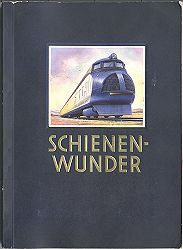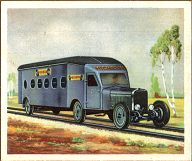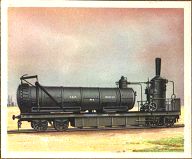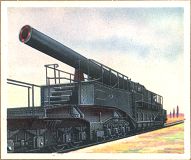Schienenwunder
Wonders of the rails


Issued by: Garbaty, Berlin
No. in set: 300
Year of issue: 1934
I am grateful to Herr Thomas Noßke who informed me that the express locomotive 03 154 shown on cards 22 and 23 and described as the most modern German express locomotive was delivered in May 1934. However other spectacular engines such as the BR05, 61 001 and EIT1998 which were delivered in 1935 are not mentioned in the album. Therefore we can assume that the album was produced in the second half of 1934 or the beginning of 1935. Köberich lists it as 1934. Incidentally Herr Noßke's site also contains other images from this album as well as other interesting information for those who can read German.
 This album illustrates rail travel of the 1930s. It is
divided into groups of six or twelve pictures, each dealing with a different
aspect. The album starts off with various steam passenger, express and goods
locomotives from around the world. There are locomotives from China to Columbia
along with views of the driver's cabin and on card 21 one of those classic views
of a man standing next to a driving wheel to show how big it is. In those days,
going fast meant big wheels. Nowadays modern technology means we can go faster
with smaller wheels, although having seen what a broken tyre on an ICE can do,
I'm not absolutely convinced.
This album illustrates rail travel of the 1930s. It is
divided into groups of six or twelve pictures, each dealing with a different
aspect. The album starts off with various steam passenger, express and goods
locomotives from around the world. There are locomotives from China to Columbia
along with views of the driver's cabin and on card 21 one of those classic views
of a man standing next to a driving wheel to show how big it is. In those days,
going fast meant big wheels. Nowadays modern technology means we can go faster
with smaller wheels, although having seen what a broken tyre on an ICE can do,
I'm not absolutely convinced.
Under goods locomotives are illustrated some Garratt locomotives - those wierd things that look like two self-propelled tenders with a boiler slung in between them. I always thought that was the name of the builders, but the Siamese version was built by Henschel & Sohn AG in Kassel.
 The fourth group shows turbine locomotives. Now I must confess that I don't
know what a turbine locomotive is. I assume it must be driven by a steam turbine
in some way. They all seem to have some wierd shaped things between the boiler
and the driving wheels. Card 40 shows a turbine express locomotive of the German
Reichsbahn. On a good day it could manage 115 km/h which is about 70mph. England
had one as well, built by the North British Locomotive Company in Glasgow. Curiously,
according to the album, this engine had a gauge of 5 feet 3 inches which is
1600mm compared with the normal gauge of 4 feet 8.5 inches (1435mm). I wonder
where it was used.
The fourth group shows turbine locomotives. Now I must confess that I don't
know what a turbine locomotive is. I assume it must be driven by a steam turbine
in some way. They all seem to have some wierd shaped things between the boiler
and the driving wheels. Card 40 shows a turbine express locomotive of the German
Reichsbahn. On a good day it could manage 115 km/h which is about 70mph. England
had one as well, built by the North British Locomotive Company in Glasgow. Curiously,
according to the album, this engine had a gauge of 5 feet 3 inches which is
1600mm compared with the normal gauge of 4 feet 8.5 inches (1435mm). I wonder
where it was used.
Actually, reading through the album, it seems that a variety of different gauges were in use in the 1930s. Narrow gauges were quite common for small railways, but it seems there were several broad gauges as well. Card 33 shows a Holland-Java goods engine with a gauge of 1760mm (5 feet 9.25 inches) whereas Russia seemed to use 1524mm (5 feet). One French express locomotive is shown with a gauge 5mm wider than the standard, although the rest of the French engines seem to be normal. Japan on the other hand apparently used a narrow gauge of 1067mm (3 feet 6 inches).
 The second section of the book deals with electric locomotives.
Card 50 shows an American electric express locomotive from Chicago. This was
another broad gauge engine with a gauge of 1676mm (5 feet 6 inches), but despite
being an express could apparently only manage 98 km/h (61 mph). The Germans
had an electric express locomotive shown on card 53 which could do 151.5 km/h
(94 mph).
The second section of the book deals with electric locomotives.
Card 50 shows an American electric express locomotive from Chicago. This was
another broad gauge engine with a gauge of 1676mm (5 feet 6 inches), but despite
being an express could apparently only manage 98 km/h (61 mph). The Germans
had an electric express locomotive shown on card 53 which could do 151.5 km/h
(94 mph).
Section three deals with diesel locomotives and secion four with special locomotives. The latter is mainly industrial locomotives and those used on cog-wheel railways, along with a few mobile cranes.
Section 5 of the album deals with trams (street cars). This includes steam trams. Although I had heard of steam trains being used on the London underground, I had never heard of a steam tram. I thought they were all electric. Actually, the steam ones don't seem to have any space for passengers, so I presume they are just engines, and the passengers travelled in carriages pulled behind.
Section 6 deals with "motor locomotives". This includes " torpedo busses" of the "rail autobahns" and "schienenzepps". The album cover in fact shows a schienenzepp of the union pacific railway - top speed 166 km/h (104 mph). One thing which this section in particular illustrates is how much the language has changed. I had not heard of any of the above expressions, and neither had anyone else I asked. Not only are there types of train which donīt exist any more, but no-one has even heard of them. "Schienenzepp" means "rail zepp". According to Herr Noßke, Schienenzepp is an abbreviation of "Schienen Zeppelin". In the railway literature, the word is used exclusively for the Krukenberg rail car. This was streamlined somewhat like a zeppelin air ship and powered by a BMW aero engine. Garbaty seem to use the word more generally.
 Back to more familiar things. Section
7 shows coaches and gives an idea of the sort of rail travel that finally came
to an end when British Rail scrapped the "Brighton Belle". The card
illustrated shows the interior of an American Pullman car. Actually it is a
sleeping car in its daytime configuration with the beds stowed. Various other
sleeping cars are illustrated. Card 212 shows an American one in nighttime configuration
with three young women resident, all carefully covering their knees. Other cards
show the kitchens and bars on board luxury trains. Some of them would put the
Ritz to shame. On the flying Scotsman it was possible to get your hair cut while
you travelled, as illustrated on card 192. The set even illustrates what the
toilets looked like. Cigarette cards of toilets might not be everyone's cup
of tea but the ones belonging to the Mitropa Gesellschaft look a lot better
than the one I have at home.
Back to more familiar things. Section
7 shows coaches and gives an idea of the sort of rail travel that finally came
to an end when British Rail scrapped the "Brighton Belle". The card
illustrated shows the interior of an American Pullman car. Actually it is a
sleeping car in its daytime configuration with the beds stowed. Various other
sleeping cars are illustrated. Card 212 shows an American one in nighttime configuration
with three young women resident, all carefully covering their knees. Other cards
show the kitchens and bars on board luxury trains. Some of them would put the
Ritz to shame. On the flying Scotsman it was possible to get your hair cut while
you travelled, as illustrated on card 192. The set even illustrates what the
toilets looked like. Cigarette cards of toilets might not be everyone's cup
of tea but the ones belonging to the Mitropa Gesellschaft look a lot better
than the one I have at home.
These weren't the only types of coaches. A lot of post travelled by rail and there is a section showing mail coaches and mobile sorting offices. Following on from these are various goods wagons. In fact quite a lot of them.
 The final section of the album deals
with special wagons. Curiously this section includes several tunnels and bridges
as well as a ship. Well I suppose they had to put them somewhere. Several types
of snow plough are illustrated. Some of them are fairly conventional with a
normal plough on the front. Two of them have large propellor type things on
the front which are supposed to sling the snow to the side of the tracks. A
Canadian train tackles the problem of snow from a different angle. It dispenses
with rails altogether and drives over the snow on caterpillar tracks. It is
steered by means of a sledge arrangement at the front and drags a row of sledges
behind it. The card illustrated is a Russian self-propelled sleeper-impregnating
train. I presume it is used for track maintenance to impregnate sleepers in
situ as otherwise it would be easier to do it in a workshop and take the
finished sleepers to wherever you needed them. Also shown is a mobile school
and a mobile hospital.
The final section of the album deals
with special wagons. Curiously this section includes several tunnels and bridges
as well as a ship. Well I suppose they had to put them somewhere. Several types
of snow plough are illustrated. Some of them are fairly conventional with a
normal plough on the front. Two of them have large propellor type things on
the front which are supposed to sling the snow to the side of the tracks. A
Canadian train tackles the problem of snow from a different angle. It dispenses
with rails altogether and drives over the snow on caterpillar tracks. It is
steered by means of a sledge arrangement at the front and drags a row of sledges
behind it. The card illustrated is a Russian self-propelled sleeper-impregnating
train. I presume it is used for track maintenance to impregnate sleepers in
situ as otherwise it would be easier to do it in a workshop and take the
finished sleepers to wherever you needed them. Also shown is a mobile school
and a mobile hospital.
Despite the luxurious aura of the times, the world was only five years away
from being plunged into the most destructive war it had ever known. This is
foreshadowed by group 31 showing military vehicles. Most of these are large
calibre guns designed to enable heavy firepower to be moved around easily. These
were enormous guns. The card illustrated shows a French gun, calibre 52cm (over
20") weighing 275 tons. 
Altogether, this is a fascinating set giving a broad look at the rail travel of a bygone age. It is the most expensive of the Garbaty sets and well worth a place in any collection if you can get hold of one.
It also appears that the pictures used for the cards were originally black and white and have been coloured by hand. The colouring used is not always completely accurate.